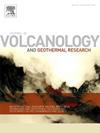Calcite priming of a hydrothermal eruption at South Orakonui, Ngā Tamariki Geothermal Field, New Zealand
IF 2.3
3区 地球科学
Q2 GEOSCIENCES, MULTIDISCIPLINARY
Journal of Volcanology and Geothermal Research
Pub Date : 2025-07-13
DOI:10.1016/j.jvolgeores.2025.108409
引用次数: 0
Abstract
On the 19th of April 2005, a small hydrothermal eruption took place at the Ngā Tamariki Geothermal Field, New Zealand. The 2005 eruption at South Orakonui cut through an existing hydrothermal eruption crater created in 1948 and ejected mud and rocks (breccia) up to 110 m from the vent. The breccia deposit thins exponentially from 2 to 3 m thick on the crater rim to <0.3 m approximately 70 m to the east with an estimated volume of ∼3.7 to ∼4.9 × 103 m3 (dependent on crater rim thickness). Polymictic ejecta include rock fragments of pumice, tuff, cemented sand/pebbles, and mudstone that are supported in an unconsolidated mud-dominated matrix. Minor clasts of coarse sand to pebble conglomerate are preserved due to cementation by calcite or alternatively in fewer samples by opal/quartz. Included in the breccia are rare platy calcite vein fragments (up to 19 cm in length); the bladed crystal morphology indicating formation from a boiling fluid. Based on the measurement of fluid inclusions in platy calcite crystals the median homogenisation temperatures of 132° to 144 °C indicate that these vein fragments were sourced from 20 to 33 m below the water table. A model for the 2005 hydrothermal eruption is proposed in which pressurisation was due to the sealing of pores and fractures by calcite deposited from a near boiling-to-boiling fluid. Lesser deposition of opal/quartz by cooling contributed to the sealing. The 2005 eruption was preceded by gradual changes in surface thermal features over 12 years seen by the declining discharge of two springs, plus the short-lived appearance then demise of another. These changes are interpreted to reflect gradual and imperfect subsurface sealing by calcite and minor opal/quartz. The eruption trigger is not known and could be due to simple over pressurisation, a slight decline in the groundwater level (<1 m), or seismic activity. Priming of an eruption by calcite sealing has not been reported for other hydrothermal eruptions in New Zealand and globally is rare. Calcite sealing may have been significant in other hydrothermal eruptions but not recognised since calcite is easily destroyed by continuing thermal activity (steam, acid condensates) and/or by weathering as is currently taking place at South Orakonui.
新西兰ngi Tamariki地热田South Orakonui热液喷发的方解石引发
2005年4月19日,新西兰的ngi Tamariki地热田发生了一次小型热液喷发。2005年南奥拉科努伊火山的喷发穿过了1948年形成的热液喷发坑,喷出的泥浆和岩石(角砾岩)高达110米。角砾岩沉积物在火山口边缘呈指数状变薄,厚度从2 ~ 3 m到0.3 m,向东约70 m,估计体积为~ 3.7 ~ ~ 4.9 × 103 m3(取决于火山口边缘厚度)。多分裂喷出物包括浮石、凝灰岩、胶结砂/卵石和泥岩的岩石碎片,它们被支撑在未固结的泥质基质中。由于方解石的胶结作用,少量粗砂到卵石砾岩的碎屑被保存下来,或者在少数样品中被蛋白石/石英胶结。角砾岩中有罕见的片状方解石脉碎片(长度可达19厘米);叶片状晶体形态表明由沸腾流体形成的叶片状晶体形态根据方解石片状晶体中流体包裹体的测量,平均均一温度为132°~ 144°C,表明这些脉状碎片来自地下水位20 ~ 33 m。提出了2005年热液喷发的一个模型,其中加压是由于从接近沸腾到沸腾的流体沉积的方解石对孔隙和裂缝的密封。冷却减少了蛋白石/石英的沉积,有助于密封。2005年的火山喷发之前,地表热特征在12年的时间里逐渐发生变化,两个泉的流量逐渐减少,加上另一个泉的短暂出现和消失。这些变化被解释为方解石和少量蛋白石/石英的逐渐和不完善的地下封闭。火山爆发的原因尚不清楚,可能是由于压力过大、地下水位轻微下降(1米)或地震活动。在新西兰和全球其他热液喷发中,方解石密封引发的喷发尚未报道,这是罕见的。方解石的封闭性可能在其他热液喷发中发挥了重要作用,但由于方解石很容易被持续的热活动(蒸汽、酸性冷凝物)和/或风化破坏,目前正在南奥拉科努伊发生。
本文章由计算机程序翻译,如有差异,请以英文原文为准。
求助全文
约1分钟内获得全文
求助全文
来源期刊
CiteScore
5.90
自引率
13.80%
发文量
183
审稿时长
19.7 weeks
期刊介绍:
An international research journal with focus on volcanic and geothermal processes and their impact on the environment and society.
Submission of papers covering the following aspects of volcanology and geothermal research are encouraged:
(1) Geological aspects of volcanic systems: volcano stratigraphy, structure and tectonic influence; eruptive history; evolution of volcanic landforms; eruption style and progress; dispersal patterns of lava and ash; analysis of real-time eruption observations.
(2) Geochemical and petrological aspects of volcanic rocks: magma genesis and evolution; crystallization; volatile compositions, solubility, and degassing; volcanic petrography and textural analysis.
(3) Hydrology, geochemistry and measurement of volcanic and hydrothermal fluids: volcanic gas emissions; fumaroles and springs; crater lakes; hydrothermal mineralization.
(4) Geophysical aspects of volcanic systems: physical properties of volcanic rocks and magmas; heat flow studies; volcano seismology, geodesy and remote sensing.
(5) Computational modeling and experimental simulation of magmatic and hydrothermal processes: eruption dynamics; magma transport and storage; plume dynamics and ash dispersal; lava flow dynamics; hydrothermal fluid flow; thermodynamics of aqueous fluids and melts.
(6) Volcano hazard and risk research: hazard zonation methodology, development of forecasting tools; assessment techniques for vulnerability and impact.

 求助内容:
求助内容: 应助结果提醒方式:
应助结果提醒方式:


